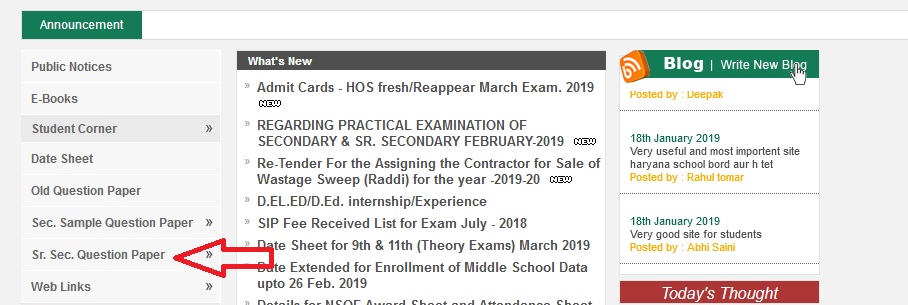BSEH Sr. Secondary Exam Chemistry Sample Question Paper 2019 : Board of School Education Haryana
Organisation : Board of School Education Haryana
Exam : Sr. Secondary Exam
Document Type : Sample Question Paper
Subject : Chemistry
Year : March 2019
Website : www.bseh.org.in/secondary-sample-question-paper/
BSEH Sr. Secondary Exam Chemistry Sample Question Paper
Sample question papers of Physics, Chemistry and Biology subjects of 10+2 class are available. Other question papers of all other subjects would be continued as per previous session 2017-2018.
Related : BSEH Sr.Secondary Exam Biology Sample Question Paper 2019 : www.pdfquestion.in/33797.html
Time allowed : 3 hours
Maximum Marks : 70
Instructions
** Please make sure that the printed pages in this question paper are 8 in number and it contains 17 questions.
** The Code No. on the top of the question paper should be written by the candidate on the front page of the answer-book.
** Before beginning to answer a question, its Serial Number must be written.
** Don’t leave blank page / pages in your answer-book.
** Except answer-book, no extra sheet will be given. Write to the point and do not strike the written answer.
** Candidates must write their Roll Number on the question paper.
** Before answering the question, ensure that you have been supplied the correct and complete question paper, no claim in this regard, will be entertained after examination.

General Instructions :
(i) All questions are compulsory.
(ii) This question paper contains 21 questions, which are divided into four Sections : A, B, C and D.
(iii) Section – A contains question number 1 having fourteen (i-xiv) objective type questions. Question from (i) to (v) multiple choice type questions. Each question carries four options, from which choose the correct option. The answer of each question from
(vi) to (xiv) may be given in one or two words or sentences. Each question carries 1 mark.
(iv) Section – B contains question numbers 2 to 11 of very short answer type questions and carry 2 marks each.
(v) Section – C contains question numbers 12 to 18 of short answer type questions and carry 3 marks each.
(vi) Section – D contains question numbers 19 to 21 of long answer type questions and carry 5 marks each.
(vii) Internal choice is available in two questions of Section-D (Long Answer Type Questions). You have to attempt only one of the given choice in such questions.
Download Question Paper :
Chemistry :
https://www.pdfquestion.in/uploads/pdf2019/33802-CHE.pdf
Section A
Objective Type Questions :
Choose the correct option of the following multiple choice questions and write in answer-book :
1. How many ions are given by the complex [Co(NH3)5 Br]SO4 in water ?
(A) 1
(B) 2
(C) 3
(D) Zero
Strongest Reducing agent is :
(A) NH3
(B) AsH3
(C) BiH3
(D) PH3
The rate law of a reaction is r = K[A]3/2 [B], then find the order of this reaction.
(A) 2/3
(B) 2.5
(C) 3
(D) 2
CH3CH2OH + H2 SO4 ¾¾¾® 413K P, P is :
(A) CH2 = CH2
(B) CH3CH2CHO
(C) (CH3CH2)2 O
(D) CH3CHO
pkb value of as compare to CH3CH2NH2 will be :
(A) More
(B) Less
(C) Equal
(D) None of these
Answer the following questions in one or two sentences :
(vi) What is cell constant ?
(vii) Write units of Second Order reaction.
(viii) What do you mean by Homogeneous Catalysis ?
(ix) Draw the structure of white phosphorus.
(x) Smoke is which type of colloid ?
(xi) Comment on the Basicity of H3PO3 acid.
(xii) Write IUPAC name of .
(xiii) Write these in order of increasing their boiling points (C2H5)2NH, n-C4H9NH2, n-C4H9OH and C2H5N(CH3)2.
(xiV) What is the main product of the reaction ? Pyridine
Section – B
Very Short Answer Type Questions :
2. Define the following terms :
(i) Crystal Lattice
(ii) Unit cell
3. How much faraday of electricity is required to produce 12 g of Mg from molten MgCl2.
4. Explain briefly the term Dialysis.
5. Describe Schottky defect.
6. Give two methods to prevent corrosion.
7. How is Ozone a strong oxidizing agent ?
8. Explain Pseudounimolecular reaction with a suitable example.
9. Draw Hawarth structure of a–D–(+) Glucopyranose.
10. Explain in brief diazotization.
11. What are polysaccharides and Globular proteins ?
Section – C
Short Answer Type Questions :
12. Explain the acidic character of hydrides of group 17 elements.
13. Explain diamagnetic behaviour of [Ni(CN)4]2– complex on the basis of valence bond theory.
14. Convert the following :
(i) Chloroethane ® Butane
(ii) Propene ® Propan-l-ol
(iii) Toluene ® Benzyl alcohol
15. Explain hydroboration oxidation reaction with a example.
16. Describe the terms Additional polymers and condensation polymers.
17. What is artificial sweetening agent ? Give two uses.
18. Outline the principle of Hall-Heroult process for the extraction of aluminium.
Section – D
Long Answer Type Questions :
19. (a) Write electronic configuration of Ti 3+ and Fe 3+ ions.
(b) What happens when acidified KMnO4 react with :
(i) FeSO4
(ii) SO2
(iii) Oxalic acid
OR
(a) Describe the preparation of K2Cr2O7.
(b) Give two uses of K2Cr2O7.
20. Describe the following :
(a) Aldol condensation
(b) Rosenmund reduction
OR
(a) Among CH3COOH, CF3COOH and HCOOH, which is a stronger acid and why ?
(b) Describe Tollens’ test and Fehling’s test.
21. Define the following terms :
(i) Molarity
(ii) Mole fraction
(b) 30 g of Urea (NH2CONH2) dissolved in 500 ml of solution. What is the osmotic pressure of the solution at 300 K.
OR
(a) Define :
(i) Abnormal molar mass
(ii) Cryoscopic constant (Kf)
(b) 18 g glucose (C6H12O6) dissolved in 500 g of water. Find depression in freezing point (DTf).